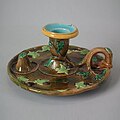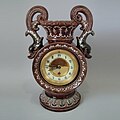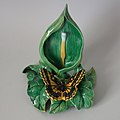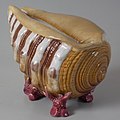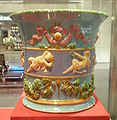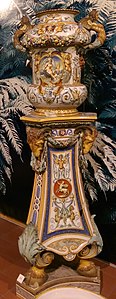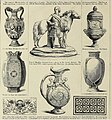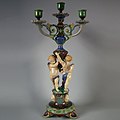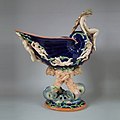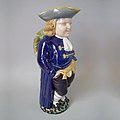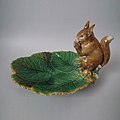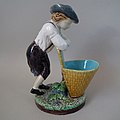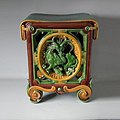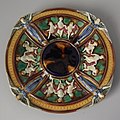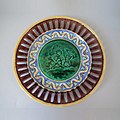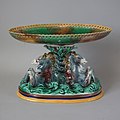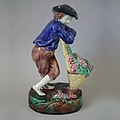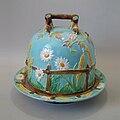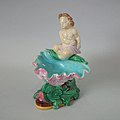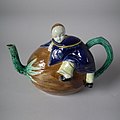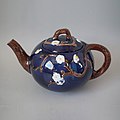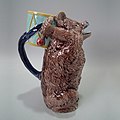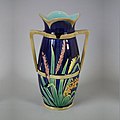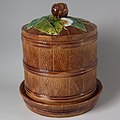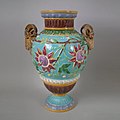
A | B | C | D | E | F | G | H | CH | I | J | K | L | M | N | O | P | Q | R | S | T | U | V | W | X | Y | Z | 0 | 1 | 2 | 3 | 4 | 5 | 6 | 7 | 8 | 9


Victorian majolica properly refers to two types of majolica made in the second half of the 19th century in Europe and America.[1]
Firstly, and best known, there is the mass-produced majolica decorated with coloured lead glazes, made in Britain, Europe and the US; typically hard-wearing, surfaces moulded in relief, vibrant translucent glazes, in occasionally classical but mostly naturalistic styles, often with an element of High Victorian whimsy.
Secondly, there is the much less common tin-glazed majolica made primarily by Mintons from 1848 to circa 1880, typically with flat surfaces, opaque white glaze with fine brush painted decoration in imitation of the Italian Renaissance maiolica process and styles.
Glazes
Glaze is a vitreous coating on a ceramic. Types of glazing include feldspathic or alkali-glazed, salt-glazed, lead-glazed, and tin-glazed.
Lead oxide is a key ingredient of both lead and tin glazes. Lead oxide is a flux that causes lead and tin glazes to fuse to the earthenware biscuit body at a low oven temperature, about 800 °C. The other ingredients in lead and tin glazes are typically an equally large quantity of silicates, and a small proportion of alkali (feldspar or similar) ground up with a little water and the large proportion of lead oxide to form a paste.
A coloured glaze results from adding a small amount of particular metal oxides to plain lead glaze, different metal oxides producing different colours.[2] Since mid-19th century coloured glazes earthenware has been known as majolica.[3]
An opaque white tin-glaze results from adding a small amount of tin oxide to plain lead glaze. Decorated with brush-painted enamels, tin-glazed earthenware from mid-15th century onwards has been known as maiolica,[4] also later as faience, delftware, talavera, or rarely majolica, though commonly majolica in USA.[5]
Coloured glazes
majolica n. 1. is earthenware decorated with coloured lead glazes applied directly to an unglazed body. Victorian majolica is the familiar mass-produced earthenware decorated with coloured lead glazes[6] made during the Victorian era (1837-1900) in Britain, Europe and the US, typically hard-wearing, surfaces frequently moulded in relief, vibrant translucent glazes, in a variety of styles and forms[7] (some examples below). Shown in Britain at the Exhibitions of 1851 and 1862,[8] it became fashionable, widely copied and mass-produced world-wide. Also known as: maiolica, Palissy ware, coloured glazes majolica, coloured-glazed majolica, lead-glazed majolica, and misleadingly 'lead or tin glazed' majolica.
Some coloured glazes majolica was produced in traditional Classical or Revivalist[9] styles, but Darwinism, natural history, their English country gardens, expeditions abroad, and trade in oriental products generated more exciting styles appealing to the upcoming merchant classes. There was a boom in Naturalistic[10] pottery, often with an element of whimsy, to which Minton's inexpensive, durable, multi-purpose product was well suited. A strong interest in the world at large generated passing fashions for Egyptian forms, Japanese styles, Chinoiserie and High Victorian style. Conservatories became a fashion statement. Adorning them were spectacular majolica garden seats, flower pots, jardinières, stands, large birds and animals. The irrepressible urge to impress guests with rare food led to the growing of pineapples and egg-plants (aubergines) formerly only available overseas. These too appeared as decorative objects for admiration around the home. Minton's Palissy ware boomed. Pottery makers throughout Britain, Europe and the US copied the process with great success, albeit variable quality. Palissy ware/Majolica went global.
-
Candelabra, 16.9 ins., coloured glazes majolica, 1864, Revivalist in style.
-
Bread plate or corn platter, temperature compatible coloured glazes on biscuit, naturalistic in style, surfaces molded in relief.
-
Tobacco Jar and cover, coloured glazes majolica, 1868, naturalistic in style.
-
Goblet, 9.2 ins., coloured glazes, c. 1869, Revivalist in style.
-
Jug, coloured glazes majolica, c. 1870, naturalistic in style, Scotland.
-
Asparagus server (table ware), 13.4ins, circa 1870, naturalistic coloured glazes majolica.
-
Strawberry jar and cover, coloured glazes, c. 1870, naturalistic style.
-
Candle holder, coloured and mottled glazes, c. 1870, Naturalistic style.
-
Dessert plate, coloured glazes, c. 1870, naturalistic style.
-
Tobacco jar and cover, c. 1870, coloured glazes, Portugal.
-
Clock, coloured glazes majolica, c.1870, Revivalist in style.
-
Vase, plain and colored lead glazes on buff biscuit, mixture of Revivalist styles.
-
Watch stand for ladies dressing table set, coloured glazes, c. 1874, naturalistic style.
-
Basket, coloured glazes majolica, 10,2ins., c.1875, naturalistic in style.
-
Spoon Warmer, coloured glazes majolica, 1876, ultra naturalistic in style.
-
Jardinière (flower pot), coloured lead glazes, Revivalist style(s).
-
Wall plate, c. 1890, coloured lead glazes Palissy majolica, Barbizet, France, ultra-naturalistic in style.
-
Toothpick holder, 5.5 ins., coloured glazes, Palissy style, Portugal.
-
Flower pot, coloured lead glazes on biscuit, naturalistic in style.
-
Teapot, c. 1875, coloured lead glazes on biscuit, Japanese style with an element of whimsy.
-
Wall Pockets, coloured glazes majolica, c.1900, Sarreguemines, France.
Tin-glaze
majolica n. 2. is earthenware, coated with opaque white tin-glaze and ornamented with metallic oxide colours. Tin-glazed Victorian majolica is the rare tin-glazed earthenware made primarily by Mintons[11] from 1848 to circa 1880, typically with flat surfaces, and opaque whitish glaze with brush painted decoration in the style(s) of Italian Renaissance maiolica tin-glazed pottery. Also known as: maiolica; and 'lead or tin' glazed majolica.
Minton's tin-glazed majolica in imitation of Italian maiolica, praised at Exhibitions and purchased by Royalty and museums, made little commercial impact. Other pottery makers shunned the process.
Interest in Renaissance styles was waning, fashion moving on with the usual protestations from older generations: "...the current of fashion, however contrary to right, wisdom, and good taste..."[12]
Cost of production was high. Compared to the lead-glaze process whereby thick, temperature-compatible coloured lead glazes were applied direct to the biscuit, simultaneously, then fired, (paint, fire), the tin-glaze process required extra stages for dipping/coating and drying the tin-glaze before decoration could even begin, (dip, dry, paint, fire). Added to this, the expense of brushwork decoration, especially the fine painting of pictures and designs, was very time-consuming, requiring highly skilled,[13] higher paid artists.
-
Minton tin-glazed Majolica plate, imitating tin-glazed Italian Renaissance maiolica process and style.
-
Minton tin-glazed Majolica bowl, 10.4ins, design an exact copy of Renaissance 9.4ins original in V&A, flat surfaces, white glaze, brush painted.
-
Minton tin-glazed Majolica oval plate, painting by Kirkby,[14] after Triumphs of Caesar (Mantegna). Almost identical example in V&A.
-
Minton tin-glazed Majolica tondino, istoriato style depicting 'Jesus among the Scribes', signed E Lessore.
-
Minton tin-glazed Majolica vase, 'grotesque' Renaissance style, 'MINTON' to the neck, mostly flat surfaces, opaque white glaze, brush painted.
-
Minton tin-glazed majolica, impressed date cypher 1864, brush-painted with enamels.
-
Tin-glazed Minton majolica, base. Note coated not dipped, date cypher 1864, signature brush-painted in manganese oxide.
Meanings of majolica
The term majolica has been dogged by confusion starting with the English anglicisation of the word maiolica into majolica following the appearance of the letter j in the English alphabet mid-17th century.[15]
Leon Arnoux, the artistic and technical director of Mintons, wrote in 1852 "We understand by majolica a pottery formed of a calcareous clay gently fired, and covered with an opaque enamel composed of sand, lead, and tin..." He was describing the Minton & Co. tin-glazed product made in imitation of Italian maiolica both in process and in styles. Remember, tin-glaze is simply plain lead glaze with a little tin oxide added. His description is often referenced,[16] in error, as a definition of Minton's other new product, the much copied and later mass-produced ceramic sensation of the Victorian era, Minton's coloured lead glazes 'Palissy ware'. The 16th-century French pottery of Bernard Palissy was well known and much admired.[17][18] Mintons adopted the name 'Palissy ware' for their new coloured glazes product, but this soon became known also as majolica.[19] Minton & Co. appear to have done little to promote the clear distinction between their tin-glazed and coloured glazes products.
Minton archive first design for majolica
Thomas Kirkby's design G144 in the Minton Archive[20] is inscribed "This is the First Design for Majolica ...". The design is Italian Renaissance in style. Close-up images illustrate a design suited for fine brushwork on flat surfaces. The design is for Minton's rare tin-glaze Majolica imitation of Italian tin-glaze maiolica. Minton's designs for Palissy ware, also known as majolica, were suited for 'thick' painting of coloured lead glazes onto surfaces moulded in relief to make best use of the intaglio effect.[21]
English Makers
Minton, the Originator
Great Exhibition (1851)
Victorian majolica was originated by Minton & Co., first exhibited at the Great Exhibition of 1851.
-
1851 Great Exhibition London, Catalogue Cover
-
1851 Exhibition Catalogue, Minton Exhibit Numbers 60 to 74. Majolica refers to Renaissance Italian maiolica.
-
Lithograph illustrating flower pots, and stands (underplates) and garden seats, see Exhibit Number 60.
-
Minton Palissy ware/ majolica flower vase, coloured glazes, shape first shown at the 1851 Exhibition, Exhibit Number 60.
-
Minton tin-glazed Majolica flower pot and stand (pedestal) in Italian Renaissance maiolica Grotesque style, see Exhibit Number 74
The 1851 Exhibition Catalogue[22] lists the two Victorian majolica products by Minton in consecutive sections.
Earthenware Flowerpots, etc. Exhibit Number 60. "A variety of flowerpots and stands, and garden seats." refers to the coloured glazes product that Mintons called Palissy ware.[23]
Tiles, Terra Cotta, and Vases, etc, in imitation of Majolica Ware. Exhibit Number 74. "Variety of flowerpots and stands, coloured in the majolica style, etc." refers to the tin-glazed product painted with enamels that Mintons called Majolica.
Exposition Universelle (1855)
The Illustrated London News reported with approval on Minton's two new products shown in Paris:
The collection of Palissy and Majolica ware, however, is that which appears to have created the greatest sensation among Parisian connoisseurs. The reader will remember that the main difference in these wares is that whereas the Palissy ware is coloured by a transparent glaze, Majolica ware contains the colour (opaque) in the material.[24] The care and taste with which these manufactures have been brought by the Messrs. Minton to their present state of perfection, have been amply rewarded. Within a few days of the opening of the Exhibition all the specimens exhibited had been sold.[25]
Despite this reminder Minton's Palissy Ware became known as 'majolica ware'; 'Palissy ware' dropped out of use and 'majolica' stuck. In the 1870s, the curators of the South Kensington Museum (now the V&A) tried to clear up the confusion by reviving the Italian spelling 'maiolica' with an 'i' instead of a 'j' for Italian tin-glaze.[26]
Great Exhibition (1862)
At the second Great Exhibition of the Art-Works of All Nations a range of Minton's products were exhibited and illustrated in the Exhibition Catalogue. Amongst them were the two Minton majolicas a) tin-glazed Minton Majolica and b) coloured glazes Minton Palissy ware soon known also as 'majolica'.
-
1862 Exhibition Minton exhibits, top left "The Italian vase is Majolica, decorated from a design by Mr. ALFRED STEVENS.", bottom middle "The EWER is a Palissy Vase."
-
Minton Majolica vase, 1862 Exhibition, process and style in imitation of Italian Renaissance maiolica. © Victoria and Albert Museum, London
-
Minton Palissy ware ewer, 1862 Exhibition, process coloured glazes majolica, style Renaissance with a touch of Naturalistic.
-
Inkstand, 1860, coloured glazes, naturalistic style.
-
Ice stand table centre, 1860, coloured glazes, Revivalist style.
-
Minton Candelabra, 1860, coloured, mottled, and plain glazes, Revivalist style.
-
Chestnut server, 1865, 11 ins., coloured glazes, naturalistic in style.
-
Nautilus shell centrepiece, 1865, coloured glazes, Revivalist style.
-
Garden Seat, 18.1 ins., coloured glazes, Chinoiserie in style, 1866.
-
'Quaker man' toby jug, 1867.
-
Gun dog Game Pie Dish, 17.3 ins., coloured and mottled glazes, naturalistic in style.
-
Nut dish, 1869, naturalistic style.
-
Vases, 1869, rare combination of fine-painted tin-glaze and coloured glazes handles, rim and interior.
-
Garden Seat, 1870, 20 ins., coloured glazes, Revivalist motifs.
-
Vintager figural, 1870.
-
Tiles, c. 1870, coloured glazes, naturalistic in style.
-
Candle Holder, 1870, coloured glazes, naturalistic in style.
-
Tureen, 1870, coloured glazes, naturalistic style.
-
Oyster server, 1870, coloured glazes, Naturalistic style.
-
Teapot, coconut, mushroom lid, 1872, coloured glazes, naturalistic style with hint of whimsy.
-
Cat and mouse jug, 1875, naturalistic style.
-
Eggplant-Aubergine vase, 1875, naturalistic style.
-
Pomegranate Vase, 1878, 22 ins., coloured glazes, boldly decorative, naturalistic and humorous in style.
-
Garden seat, 1880, coloured glazes, in imitation of Tang dynasty sancai.
Wedgwood
Wedgwood began to manufacture majolica about ten years after Mintons. Wedgwood's glazes and modelling were denser and more formal than Minton's, but there were many pieces that displayed the naturalism and humour of Minton shapes. Wedgwood's majolica included cachepots, jugs, candlesticks, cheese bells, umbrella stands, sardine boxes, plates in naturalistic patterns, bread trays, etc. In Wedgwood's "greenware" the green glaze emphasizes the low relief patterning, typically of basketwork and foliage. Numerous smaller factories in the Staffordshire Potteries specialised in such green majolica wares in which the translucent glaze brought out the low relief of the cast body: some, like Wedgwood, marked their majolica with impressed stamps.
Majolica was influenced by the design of the old "Cauliflower" and "Pineapple" teapots that had been made by Thomas Whieldon, Wedgwood and other 18th-century Staffordshire potters. Both English and American majolica potters reproduced the "Cauliflower" pattern and other raised fruit, vegetable, leaf, and berry patterns, with green, yellow, pink, brown, light blue and purple-blue glazes. There is also a teapot of yellow corn and green leaves, similar to the old Whieldon "Pineapple" teapots, and a teapot, jug and sugar bowl of pink coral and green seaweed with accents of brown and blue, marked "Etruscan Majolica". Many late 19th-century majolica designs had rustic motifs with backgrounds of basketry and wooden-bound buckets decorated with moulded flowers, birds, fish and animals. Handles were made to resemble tree branches, rose stems and twined flowers and leaves.
Plates, jugs, teapots and other articles were moulded with the shapes of wild roses, lily pads and herons, begonia leaves, shells, coral, seaweed, corn and bamboo stalks, cabbage leaves, strawberries, ferns and sprays of flowers, borders of basketry and oriental motifs.
-
Coloured glazes majolica Angels dessert plate, c. 1867, Revivalist in style.
-
Coloured glazes majolica centrepiece 16.3ins., c.1889, Revivalist and Naturalistic in style.
-
Coloured glazes majolica primroses cheese keep, c. 1876, Naturalistic in style.
-
Coloured glazes majolica, intaglio pictorial centre 'Email Ombrant', c.1871, Classical style.
-
Mottled coloured glazes Victorian majolica, c.1865, border in Greek key style.
-
Coloured glazes majolica hippocamp centrepiece, c. 1869, Classical mythology in style.
-
Coloured glazes majolica figural vintager, c. 1875, Naturalistic in style.
George Jones
The Trent Pottery, George Jones and Sons, made majolica cupids, shells, dolphins, birds, figurines and coral designs in numerous shapes including highbrow centrepieces alongside snuff boxes, spittoons, dog bowls, vases, serving dishes, tea sets, jugs, cheese keeps, desk sets, garden seats and pie dishes. Their mark was a monogram of the initials "G.J." joined together. A beehive bread dish with a cover has a design of wild roses against a background of basketwork and has the Trent Pottery mark. Also flowerpots were made in bright colours and with raised designs of natural flowers.
-
Squirrel nut dish, 1869, naturalistic style.
-
'Neptune', coloured glazes, 1870, Revivalist influence.
-
Spitoon, coloured glazes majolica, c.1880
-
Snuff box, coloured glazes majolica with pewter lid, c.1870, naturalistic goat figure.
-
Amphora vase, 1870, Egyptian style.
-
Flower pot, coloured lead glazes on biscuit, raised design of natural flowers.
-
Bird jug, 1870, naturalistic style.
-
Cheese keep and stand, 1870, naturalistic style.
-
Ladies desk set for inks, sand and quills, 1871, naturalistic style.
-
Lily dish with kingfisher, 1873, naturalistic style.
-
Trinket dish, coloured glazes, c. 1874, spectacularly Naturalistic in style.
-
Tea set, 1873, naturalistic apple blossom pattern.
-
Garden seat, 1875, naturalistic style.
-
Merman and dolphin dish, 1875, Revivalist style.
-
Sardine dish, coloured glazes, c. 1875, spectacularly naturalistic.
-
Pie dish, coloured glazes, c. 1877, spectacularly Naturalistic in style.
-
Frog and insect vase, c. 1880, naturalistic in style.
Joseph Holdcroft
-
Coloured glazes Oriental Boy on Coconut Teapot and cover c 1870.
-
Coloured glazes Floral Teapot and cover c 1880.
-
Coloured glazes cheese keep, naturalistic style.
-
Coloured glazes garden seat, naturalistic style.
-
Coloured glazes fish and lilies jardiniere, naturalistic style.
-
Holdcroft Jug, 9.6 ins., circa 1870, naturalistic coloured glazes majolica.
-
Holdcroft Asparagus server table ware, 13.4ins, circa 1870, naturalistic coloured glazes majolica.
-
Holdcroft Dessert plate, coloured glazes, circa 1870, naturalistic style.
-
Wall Pocket, c.1870. Coloured glazes, naturalistic in style.
-
Cheese Dome and Stand, c.1880. Coloured glazes, naturalistic in style.
-
Coloured glazes box and cover, Aesthetic style, c. 1880
-
Coloured glazes swan vase, c.1875, naturalistic in style.
-
Coloured glazes swan base, impressed pattern number.
-
Coloured glazes frog toothpick holder, c. 1870
Brownfield
-
Coloured glazes vase c.1875.
-
Chestnut finial coloured glazes dish and cover c.1880
-
Cats Vase, coloured glazes, c.1875.
-
Cheese keep and underplate, coloured glazes, c.1870.
-
Coloured glazes majolica Cockatoo, c.1870.
-
Brownfield coloured glazes majolica Sauceboat, c.1870, Revivalist references.
-
Brownfield Peasant Figures, 13.2 ins., coloured glazes majolica, c.1880.
Brown Westhead Moore
-
Garden Seat, coloured lead glazes.
-
Butterfly box and cover, coloured glazes, c.1860.
-
Rabbit box and cover, coloured glazes, c.1870.
-
Vase, coloured glazes, c.1875.
-
Brown Westhead Moore coloured glazes hexagonal teapot and cover c 1870.
Zdroj:https://en.wikipedia.org?pojem=Victorian_majolica
Text je dostupný za podmienok Creative Commons Attribution/Share-Alike License 3.0 Unported; prípadne za ďalších podmienok. Podrobnejšie informácie nájdete na stránke Podmienky použitia.
Antropológia
Aplikované vedy
Bibliometria
Dejiny vedy
Encyklopédie
Filozofia vedy
Forenzné vedy
Humanitné vedy
Knižničná veda
Kryogenika
Kryptológia
Kulturológia
Literárna veda
Medzidisciplinárne oblasti
Metódy kvantitatívnej analýzy
Metavedy
Metodika
Text je dostupný za podmienok Creative
Commons Attribution/Share-Alike License 3.0 Unported; prípadne za ďalších
podmienok.
Podrobnejšie informácie nájdete na stránke Podmienky
použitia.
www.astronomia.sk | www.biologia.sk | www.botanika.sk | www.dejiny.sk | www.economy.sk | www.elektrotechnika.sk | www.estetika.sk | www.farmakologia.sk | www.filozofia.sk | Fyzika | www.futurologia.sk | www.genetika.sk | www.chemia.sk | www.lingvistika.sk | www.politologia.sk | www.psychologia.sk | www.sexuologia.sk | www.sociologia.sk | www.veda.sk I www.zoologia.sk








